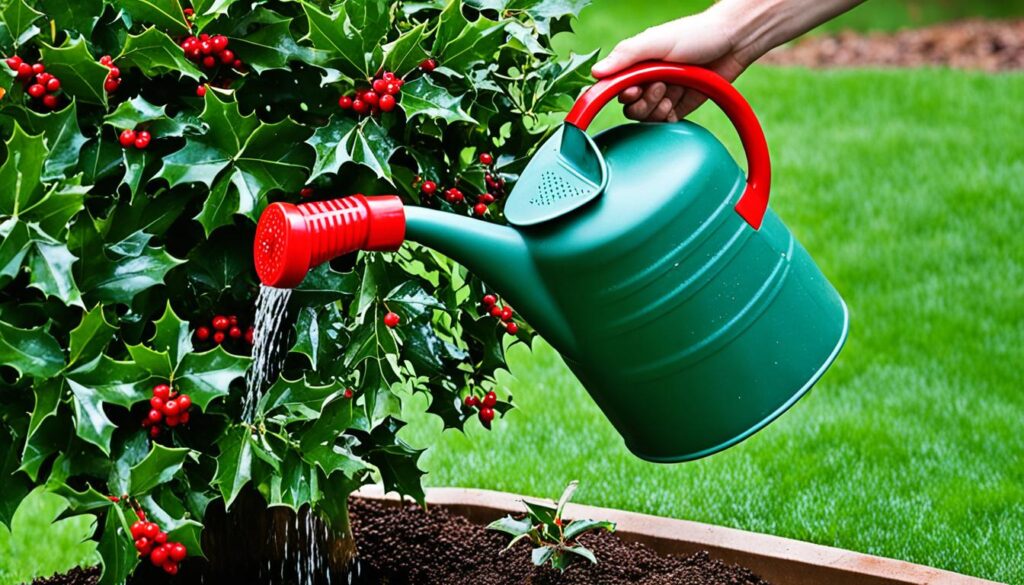
Have you ever thought about holly trees‘ fascinating history and uses? These shrubs are evergreen, staying green all year, with bright red berries and prickly leaves. They are a key part of our winter gardens and festive seasons. Besides being famous for their festive foliage, holly is a wide-ranging group with over 400 types. They include both tall trees and small, dense evergreen shrubs. You can learn the secrets of growing, looking after, and picking the right kind of holly for your landscape and Christmas decorations.
Introduction to Holly Trees
Holly is a big group of evergreen shrub and deciduous holly trees. There are over 400 types found in many parts of the world. They can grow very tall or stay small. Most holly trees are known for their bright red berries, especially in the winter. This makes them great for looks and festive decorations.
What are Holly Trees?
Ilex species, which we call holly trees, are flowering plants. They are part of the Aquifoliaceae family. You can find them in many places, except Antarctica and Australia. The most types are in East Asia and the Americas.
History and Cultural Significance
For a long time, holly trees have been important in culture. They’re linked to many traditions, especially during the holidays. People have been using holly trees in winter celebrations since ancient times. They saw the green leaves and winter berries as signs of life and hope in winter.
Varieties of Holly Trees
There are many kinds of holly trees. Some are evergreen shrub types, others lose their leaves. They have different leaf shapes, textures, and berry colors. This variety lets gardeners find the best holly trees for their gardens or landscapes.
Planting Holly Trees
Selecting the right spot and preparing the ground well is key for holly plants to grow best. They love full sunlight requirements or partial shade. Holly also needs well-draining, slightly acidic soil. Start by loosening the soil where you’ll plant to 8-12 inches deep.
Site Selection and Sunlight Requirements
Look for a place that gets at least 6 hours of direct sunlight daily. Holly can deal with a bit of shade, but too much will stop it from blooming and making berries. Make sure the ground drains well and doesn’t hold water, as too much water is bad for holly.
Soil Preparation and Planting Steps
Prepare a hole twice as wide and a bit deeper than the plant’s root ball. Carefully take the plant out of its container, watching out for the roots. Gently loosen tight roots with your fingers. This helps them spread. Place the plant in the hole so its top is level with the soil. Fill the hole back up with soil and pack it down gently to remove air. Then, water it well to settle the soil and help the roots start growing.

Keep your holly plant well-watered regularly until it’s strong, which could be 1-2 years. By choosing the best spot, preparing the ground right, and planting well, you will enjoy these beautiful evergreens for years to come.
Caring for Holly Trees
It’s key to take good care of your holly trees to keep them healthy and beautiful. From how often to water them to cutting them back, there are steps to follow. These will ensure your holly plants do well.
Watering Needs
Holly plants like to be watered regularly. A constant level of moisture in the soil is best. But, don’t let the soil dry out completely or get too wet. In dry or hot weather, water more to keep the leaves from drooping.
Too much water can harm your plants by causing root rot. So, always check the soil to see if it needs more water. Then, adjust your watering to keep your holly trees happy.
Fertilizing Recommendations
To help your holly trees grow strong, feed them twice a year. Do this with a slow-release fertilizer made for holly trees or acid-loving plants. This will give them the nutrients they need for healthy leaves and lots of berries.
Make sure to follow the instructions on the fertilizer bag. This tells you the right amount to use and how to put it on your plants.
Pruning and Shaping
Maintaining the right shape of your holly trees is important. Start by cutting off any branches that are dead, sick, or growing into each other. This keeps your trees looking good.
If you want a neat look, trim the branches that are sticking out. But, remember, holly trees generally look nicest when you keep their natural shape and size. Some holly types, like Japanese hollies, can be cut back a lot. They make great hedges or topiaries.

holly tree Varieties and Characteristics
Holly plants vary in size. They can be big trees or small bushes. They are available in both evergreen and deciduous types. Some well-known holly tree varieties are English holly, Winterberry holly, Japanese holly, Blue holly, and Inkberry.
Evergreen vs. Deciduous Holly Trees
Evergreen holly trees, like English holly, keep their spiky, shiny leaves all year. This brings a green look to the area, even in winter. On the other hand, deciduous holly trees, such as Winterberry holly, lose their leaves in fall. Then, they reveal their bright red, yellow, or black holly berries, adding color during the winter.
Popular Holly Tree Varieties
English holly (Ilex aquifolium) is a beloved evergreen, known for its shiny, dark green foliage and red berries. Winterberry holly (I. verticillata) is a deciduous type that stands out with its red berries after its leaves fall. Japanese holly (I. crenata) is a small, slow-growing evergreen. It has tiny, glossy leaves. Blue holly (I. x meserveae) has unique blue-green foliage and lots of berries. Inkberry (I. glabra) is an adaptable evergreen shrub. It features dark green, tough leaves and black berries.
Ornamental Features and Berries
Holly is known for its spiky, shiny leaves and bright holly berries. These features add beauty and interest to the landscape. The berries, which come in red, yellow, or black, are iconic during the holidays. They are commonly used in Christmas decor and feed wildlife.

Landscaping with Holly Trees
Holly plants are versatile in the garden. They can be elegant hedges, privacy screens, or eye-catching elements in different spots. If you want a dense hedge or to showcase their beauty, there are many holly types you can choose from.
Hedges and Screening
Holly plants like Ilex ‘Nellie r. Stevens’ and Ilex opaca are great for privacy or formal looks. They have shiny leaves and grow evenly, making a beautiful barrier. For the best effect, plant them in places that get sun or some shade. Space them 3-5 feet apart for a solid look.
Foundation Plantings
Smaller hollies, such as Ilex crenata ‘Compacta’ and Ilex glabra ‘Shamrock’, are good for the base of your home. They keep the space green and inviting year-round. Make sure to plant them in soil that drains well and gets lots of sun.
Containers and Topiaries
Hollys work well in pots or as shaped plants, like topiaries. Varieties such as Ilex crenata ‘Sky Pencil’ and Ilex x meserveae ‘Blue Maid’ are ideal. They stay narrow and small. Put them in sunny areas and water them regularly without letting the soil get too wet.
Pests and Diseases
Holly trees are strong but can still get hurt by some pests and diseases. Knowing the problems and how to stop them keeps your trees lively and healthy.
Common Pests Affecting Holly Trees
The holly leaf miner is a tricky pest for holly trees. It’s a small fly whose babies eat the leaves, making them look bad. While this pest doesn’t directly kill the tree, it makes it look less nice. The best way to deal with the holly leaf miner is to check the leaves often. Take off the bad ones and destroy them.
Disease Prevention and Management
Holly trees can catch a fungal disease called holly leaf blight. It’s caused by a pathogen called Phytophthora ilicis. This disease makes the leaves change color, fall off, and can even make the plant die. Sadly, there’s no cure for holly leaf blight. The best thing to do is cut off and destroy any parts that are sick. This stops the disease from spreading to the healthy parts.
To fight off pests and diseases, take good care of your holly trees. This means watering them enough, giving them the food they need, and snipping the branches when needed. Also, picking types of holly that resist diseases and putting them in the right spot helps a lot. It keeps your holly trees strong and happy.
Propagating Holly Trees
Hollies can be grown from seeds or cuttings, letting you add more to your garden. Whether from seeds or cuttings, growing hollies takes patience since they grow slowly.
Seed Propagation
Start by gathering berries in late winter or early spring. Take the small seeds out, and plant them in good compost. Keep the soil moist, and holly seeds will start growing in a few weeks to a few months.
Cutting Propagation
Propagating holly with cuttings is also a good way. Take cuttings in the late summer or winter. Prep the ends, use a rooting hormone, and plant in soil that drains well.
Make sure the soil stays moist as the cutting roots. This can take a few months.
Choosing seeds or cuttings for holly propagation both need time. Holly plants grow slowly. So be patient as you wait for them to grow strong and beautiful.
Holly Tree Symbolism and Uses
Holly is rich in cultural and traditional meaning, especially for Christmas and winter. Its green leaves and red berries are loved for holly Christmas decorations. These include wreaths, garlands, and centerpieces, showing life and hope in the cold.
Holly is more than just looks. In some traditions, its prickly leaves stand for Christ’s crown of thorns. The red berries, in this view, are his blood. Many see holly as a symbol of fertility, protection, and luck during the winter solstice.
Besides adorning homes at Christmas, holly is used in crafts. Its shiny leaves and berries go into potpourri, candles, and dried flower designs. This adds a natural charm to handmade items.
| Holly Tree Symbolism | Holly Tree Uses |
|---|---|
|
|
Buying and Planting Guide
When you buy a holly tree, pay attention to its size and how it grows. Think if it needs a male and female partner to make berries. Make sure it looks healthy before you buy it. You can find holly trees at local nurseries, garden centers, and online.
After picking the right holly tree, it’s time to plant. Choose a spot with the right sunlight and soil for the tree. Plant it correctly by digging a wide hole, keeping the top of the roots even with the ground. Water it well and take care of it until it’s established.
Think about what holly tree type fits your garden. Follow the best planting methods. Whether for a hedge, winter beauty, or for its classic look, a well-chosen holly tree will flourish for a long time.



